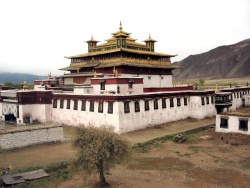Council of Lhasa
The Council of Lhasa, also called the Council of Samye (by Tucci) or the Great Debate, was a debate from 792 to 794 at the Samye Monastery in Tibet.
King Trisong Detsen of Tibet had first invited Moheyan, at that time teaching in the area of Dunhuang, to settle at Samye Monastery, then the center of emerging Tibetan Buddhism. Moheyan promulgated a variety of Chan and disseminated teachings from Samye where he attracted a considerable number of followers.
However, in 793 Trisong Detsen resolved that Moheyan did not hold the true Dharma. Following intense protests from Moheyan’s supporters, Trisong Detsen proposed to settle the matter by sponsoring a debate: dialectic is an ancient aspect of the Indian and Chinese religions, as it is in Himalayan tradition. The most famous of these debates has become known as the "Council of Lhasa", although it may have taken place at Samye, a considerable distance from Lhasa. For the famed Council of Lhasa, an Indian monk named Kamalaśila was invited to represent Indian Buddhism, while Moheyan represented Northern School Chán and Chinese Buddhism. Most Tibetan sources state that the debate was decided in Kamasila’s favour (though many Chinese sources claim Moheyan won) and Moheyan was required to leave the country and that all sudden-enlightenment texts were gathered and destroyed by royal decree. This was a pivotal event in the history of Tibetan Buddhism, which would afterward continue to follow the late Indian model with only minor influence from China. Moheyan’s teachings were a mixture of the 'East Mountain Teachings' {Chinese: tung-shan fa-men; given the appellation of "Northern School" Chan by Shenhui (670-762)} associated with Shenxiu and Baotang Chán.
Broughton (1983: p. 9) identifies the Chinese and Tibetan nomenclature of Mohoyen's teachings and identifies them principally with the East Mountain Teachings:
Mo-ho-yen's teaching in Tibet as the famed proponent of the all-at-once gate can be summarized as "gazing-at-mind" (Chinese: 看心 k'an-hsin... = Tibetan: sems la bltas) and "no examining" (Chinese: pu-kuan... = Tibetan: mi rtog pa) or "no-thought no-examining" (Chinese: pu-ssu pu-kuan... = Tibetan: mi bsam mi rtog). "Gazing-at-mind" is an original Northern (or East Mountain Dharma Gate) teaching. As will become clear, Poa-t'ang and the Northern Ch'an dovetail in the Tibetan sources. Mo-ho-yen's teaching seems typical of late Northern Ch'an. Mo-ho-yen arrived on the central Tibetan scene somewhat late in comparison to the Ch'an transmissions from Szechwan.
